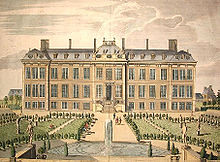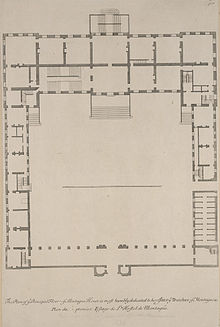Montagu House (Bloomsbury)
Montagu House , sometimes spelled Montague House , was a late 17th century mansion on Great Russell Street in Bloomsbury , a district of the British capital, London . It was the first location of the British Museum .
The house was actually built twice, each time commissioned by the same man, Ralph Montagu, 1st Duke of Montagu . At the end of the 17th century, Bloomsbury was very fashionable as a location for sumptuous city residences, and Lord Montagu acquired land that was now in the center of London, but then bordered an open field. The first version of this house was designed by the English architect and scientist Robert Hooke , a builder with limited skills whose style was influenced by the French way of planning and the Dutch way of detailing. The house was built between 1675 and 1679. It had a central block and two servant wings, which were arranged around a central courtyard. The house aroused the admiration of contemporaries. It was decorated with frescoes by the Italian artist Antonio Verrio and the French painter Jacques Rousseau also contributed some wall paintings. In 1686 this house was destroyed by fire.
It was then rebuilt according to the plans of an otherwise unknown French named Pouget . This Montagu House was the grandest private residence built in London over the last two decades of the 17th century. The main facade was 17 bays wide, with 3 bays protruding slightly in the middle and the three bays at each end of the wing for the service staff of the old house. The house had two main floors and an additional cellar and an excellent mansard roof with a dome in the middle. The new house was planned in the shape customary in France at the time, with showrooms that connected to a centrally located salon on both sides. The interiors, decorated by French artists, were admired by Horace Walpole and were comparable to the preserved parade rooms of Boughton House in Northamptonshire , which were built by the same builder at the same time.
In the early 18th century, Bloomsbury began to evolve from a fashionable aristocratic neighborhood to a more middle-class neighborhood, and so the 2nd Duke of Montagu gave up his father's house and moved to Whitehall . He had a more modest residence built there himself, which was later expanded into an opulent mansion by his descendant, Walter Montagu Douglas Scott, 5th Duke of Buccleuch , see Montagu House (Whitehall) .
Montagu House in Bloomsbury was sold to trustees of the British Museum in 1759 and served as its location until the 1840s. Then it was demolished in favor of a larger building that had become necessary.
In the literature
Montagu House appears in Neal Stephenson's Baroque cycle as Ravenscar House . There Daniel Waterhouse takes the place of the architect Hooke.
Individual evidence
- ^ Rousseau, Jacques (1630-1693) . Encyclopaedia Britannica, via Wikisource.Retrieved September 21, 2015.
swell
- Howard Colvin: A Biographical Dictionary of British Architects .
- David Pearce: London's Mansions .
Coordinates: 51 ° 31 ′ 9.5 ″ N , 0 ° 7 ′ 37 ″ W.


